目录
前言
一、什么是C++
1.1 C++关键字(C++98)
二、命名空间
2.1 命名空间定义
1.正常命名空间的定义
2.命名空间的定义可以嵌套
3.同名的命名空间会合并
2.2 命名空间的使用
三、C++输入&输出
四、缺省参数
4.1 缺省参数概念
4.2 缺省参数分类
五、函数重载
5.1 函数重载分类
1.参数类型不同
2.参数个数不同
3.参数类型顺序不同
5.2 函数重载的原理
六、引用
6.1 引用概念
6.2 引用的特性
6.3 常引用
6.4 使用场景
6.5 传值、传引用效率比较
6.6 引用和指针的区别
七、内敛函数
7.1 概念
7.2 特性
八、auto关键字
8.1 auto的使用细则
1. auto与指针和引用结合起来使用
2. 在同一行定义多个变量
8.2 auto不能推导的场景
1. auto不能作为函数的参数
2. auto不能直接用来声明数组
九、基于范围的for循环(C++11)
十、指针空值nullptr(C++11)
总结
前言
今天我们就要来学习C++的知识了,通过C语言来过度到C++,首先我们先来了解一下C++中的入门语法,比如命名空间,缺省参数,函数的重载等知识。
一、什么是C++
C语言是结构化和模块化的语言,适合处理较小规模的程序。对于复杂的问题,规模较大的程序,需要高度的抽象和建模时,C语言则不合适。为了解决软件危机, 20世纪80年代, 计算机界提出了OOP(objectoriented programming:面向对象)思想,支持面向对象的程序设计语言应运而生。
1982年,Bjarne Stroustrup博士在C语言的基础上引入并扩充了面向对象的概念,发明了一种新的程序语言。为了表达该语言与C语言的渊源关系,命名为C++。因此:C++是基于C语言而产生的,它既可以进行C语言的过程化程序设计,又可以进行以抽象数据类型为特点的基于对象的程序设计,还可以进行面向对象的程序设计。
1.1 C++关键字(C++98)
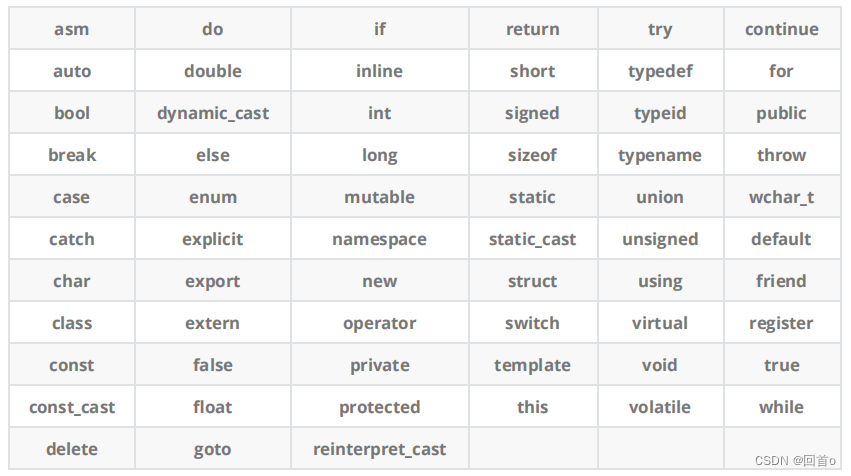
二、命名空间
#include <stdio.h>
#include <stdlib.h>int rand = 10;
// C语言没办法解决类似这样的命名冲突问题,所以C++提出了namespace来解决
int main()
{printf("%d\n", rand);return 0;
}
// 编译后后报错:error C2365: “rand”: 重定义;以前的定义是“函数”2.1 命名空间定义
1.正常命名空间的定义
namespace bit
{// 命名空间中可以定义变量/函数/类型int rand = 10;int Add(int left, int right){return left + right;}struct Node{struct Node* next;int val;};
}2.命名空间的定义可以嵌套
//2. 命名空间可以嵌套
// test.cpp
namespace N1
{
int a;
int b;
int Add(int left, int right){return left + right;}
namespace N2{int c;int d;int Sub(int left, int right){return left - right;}}
}3.同名的命名空间会合并
3. 同一个工程中允许存在多个相同名称的命名空间,编译器最后会合成同一个命名空间中。
// ps:一个工程中的test.h和上面test.cpp中两个N1会被合并成一个
// test.h
namespace N1
{
int Mul(int left, int right){return left * right;}
}2.2 命名空间的使用
默认操作规则:局部——全局(如果通过using展开(声明)了命名空间,才会到命名空间查找)
namespace bit
{// 命名空间中可以定义变量/函数/类型int a = 0;int b = 1;int Add(int left, int right){return left + right;}struct Node{struct Node* next;int val;};
}
int main()
{// 编译报错:error C2065: “a”: 未声明的标识符printf("%d\n", a);return 0;
}int main()
{printf("%d\n", N::a);return 0;
}2.使用using将命名空间中某个成员引入
using N::b;
int main()
{printf("%d\n", N::a);printf("%d\n", b);return 0;
}3.使用using namespace 命名空间名称 引入
using namespce N;
int main()
{printf("%d\n", N::a);printf("%d\n", b);Add(10, 20);return 0;
}在比较大的工程项目中,一般不展开命名空间。
三、C++输入&输出
#include<iostream>
// std是C++标准库的命名空间名,C++将标准库的定义实现都放到这个命名空间中
using namespace std;
int main()
{cout<<"Hello world!!!"<<endl;return 0;
}#include <iostream>
using namespace std;
int main()
{int a;double b;char c;// 可以自动识别变量的类型cin>>a;cin>>b>>c;cout<<a<<endl;cout<<b<<" "<<c<<endl;return 0;
}四、缺省参数
4.1 缺省参数概念
void Func(int a = 0)
{cout<<a<<endl;
}
int main()
{Func(); // 没有传参时,使用参数的默认值Func(10); // 传参时,使用指定的实参return 0;
}4.2 缺省参数分类
void Func(int a = 10, int b = 20, int c = 30){cout<<"a = "<<a<<endl;cout<<"b = "<<b<<endl;cout<<"c = "<<c<<endl;}void Func(int a, int b = 10, int c = 20){cout<<"a = "<<a<<endl;cout<<"b = "<<b<<endl;cout<<"c = "<<c<<endl;}注意:
//a.hvoid Func(int a = 10);// a.cppvoid Func(int a = 20){}// 注意:如果生命与定义位置同时出现,恰巧两个位置提供的值不同,那编译器就无法确定到底该//用那个缺省值。应用:我们可以在需要扩容的数据结构中用缺省参数给一个初始值,避免扩容次数过多。
五、函数重载
5.1 函数重载分类
1.参数类型不同
#include<iostream>
using namespace std;
// 1、参数类型不同
int Add(int left, int right)
{cout << "int Add(int left, int right)" << endl;return left + right;
}
double Add(double left, double right)
{cout << "double Add(double left, double right)" << endl;return left + right;
}2.参数个数不同
void f()
{cout << "f()" << endl;
}
void f(int a)
{cout << "f(int a)" << endl;
}3.参数类型顺序不同
void f(int a, char b)
{cout << "f(int a,char b)" << endl;
}
void f(char b, int a)
{cout << "f(char b, int a)" << endl;
}5.2 函数重载的原理
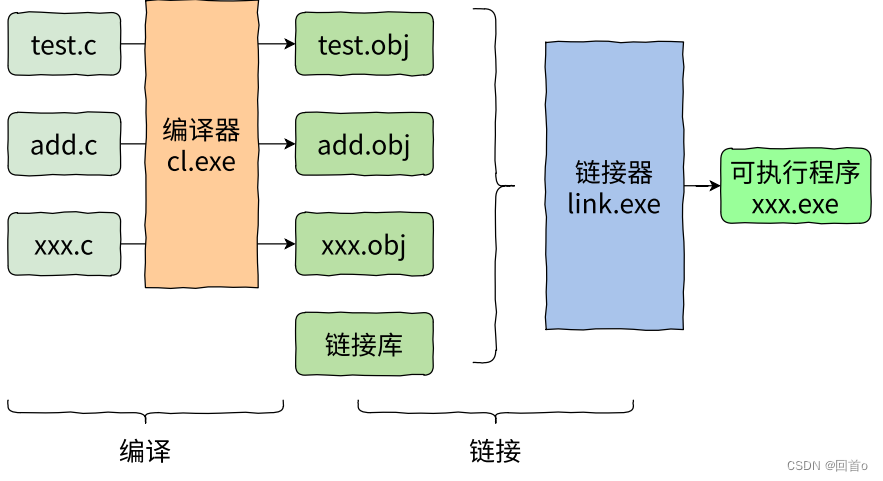
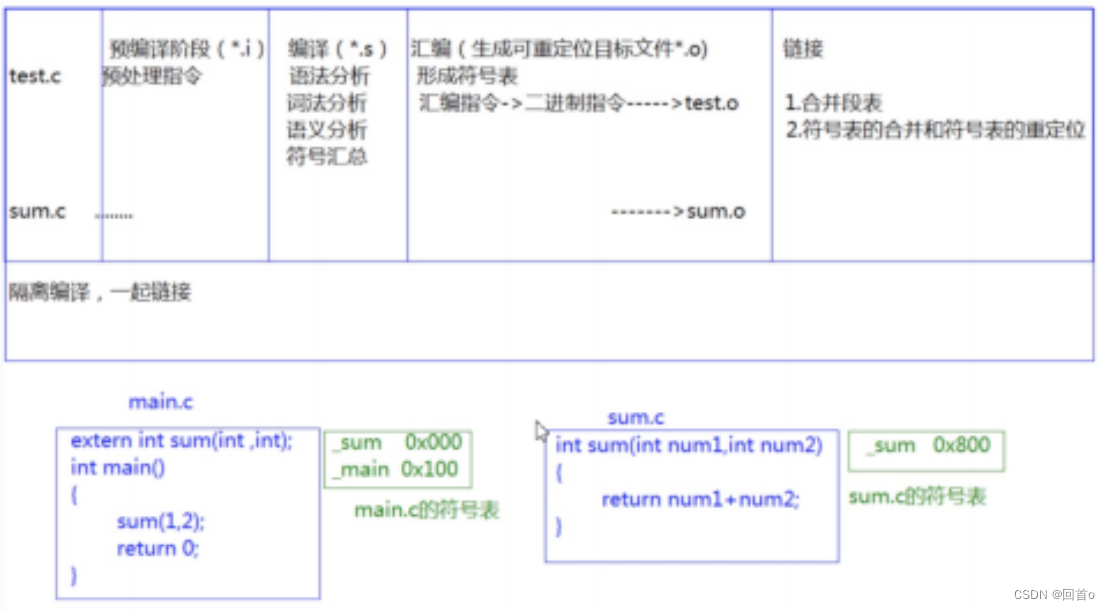

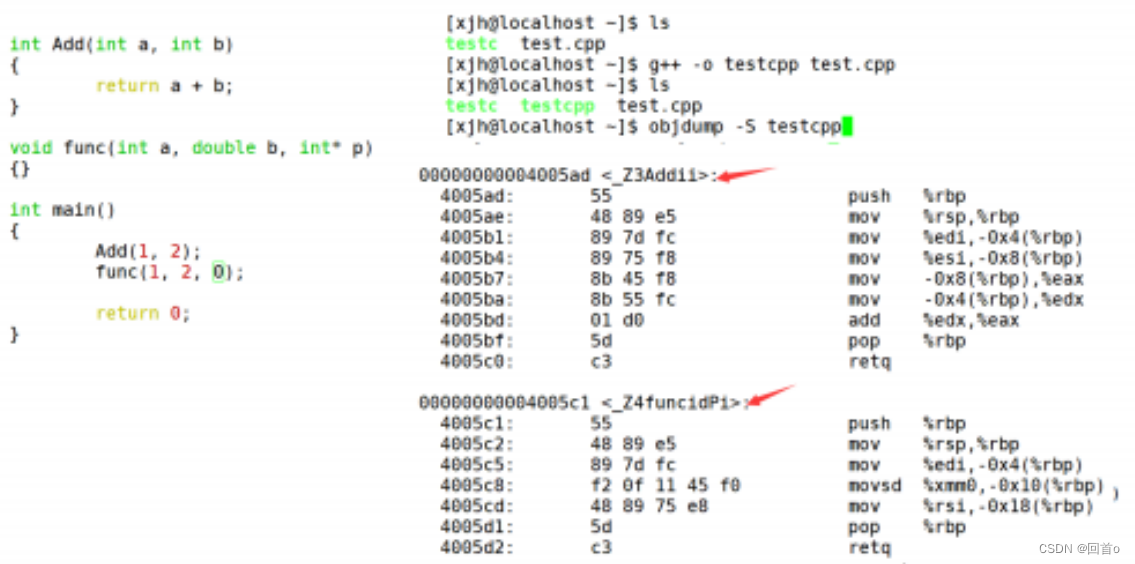
所以为什么C++支持重载,而C语言不支持重载?
因为在链接过程中,C语言直接通过函数名去查找,所以不支持重载。而C++通过函数名字修饰规则修饰后的函数名去查找的,所以支持重载。
六、引用
6.1 引用概念
void TestRef()
{int a = 10;int& ra = a;//<====定义引用类型printf("%p\n", &a);printf("%p\n", &ra);
}6.2 引用的特性
void TestRef()
{int a = 10;// int& ra; // 该条语句编译时会出错 必须初始化int& ra = a;int& rra = a;printf("%p %p %p\n", &a, &ra, &rra);
}6.3 常引用
void TestConstRef()
{const int a = 10;//int& ra = a; // 该语句编译时会出错,a为常量const int& ra = a;// int& b = 10; // 该语句编译时会出错,b为常量const int& b = 10;double d = 12.34;//int& rd = d; // 该语句编译时会出错,类型不同const int& rd = d;//隐式类型转换
}其中权限可以缩小,平移,就是不可以放大。
const int& rd =d发生了隐式类型转换,相当于把d给rd时会产生一个int类型的临时变量,然后再把这个变量给rd,这个变量具有常性,所以要加const,不加也相当于权限的放大。
6.4 使用场景
void Swap(int& left, int& right)
{int temp = left;left = right;right = temp;
}2.做返回值
int& Count()
{static int n = 0;n++;// ...return n;
}6.5 传值、传引用效率比较
#include <time.h>
struct A{ int a[10000]; };
void TestFunc1(A a){}
void TestFunc2(A& a){}
void TestRefAndValue()
{A a;// 以值作为函数参数size_t begin1 = clock();for (size_t i = 0; i < 10000; ++i)TestFunc1(a);size_t end1 = clock();// 以引用作为函数参数size_t begin2 = clock();for (size_t i = 0; i < 10000; ++i)TestFunc2(a);size_t end2 = clock();
// 分别计算两个函数运行结束后的时间cout << "TestFunc1(A)-time:" << end1 - begin1 << endl;cout << "TestFunc2(A&)-time:" << end2 - begin2 << endl;
}
可以看到传引用比传值效率跟高。
6.6 引用和指针的区别
int main()
{int a = 10;int& ra = a;cout<<"&a = "<<&a<<endl;cout<<"&ra = "<<&ra<<endl;return 0;
}int main()
{int a = 10;int& ra = a;ra = 20;int* pa = &a;*pa = 20;return 0;
}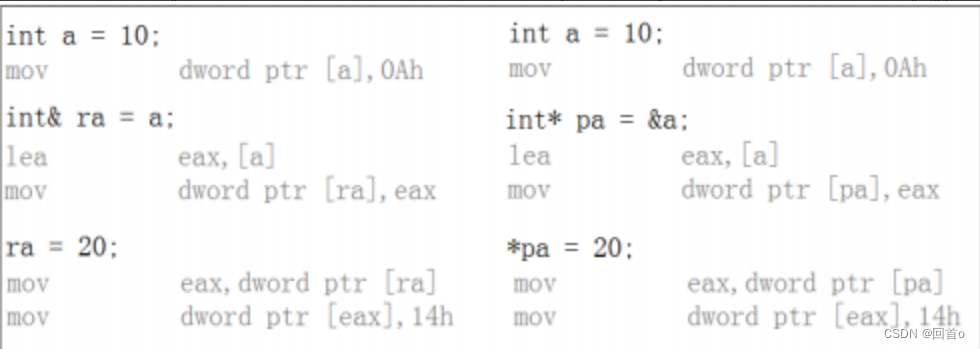
七、内敛函数
7.1 概念
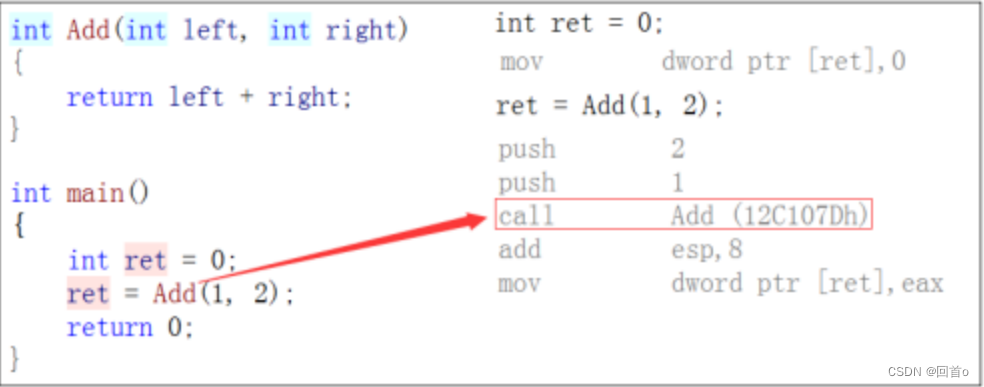

7.2 特性
八、auto关键字
int TestAuto()
{return 10;
}
int main()
{int a = 10;auto b = a;auto c = 'a';auto d = TestAuto();cout << typeid(b).name() << endl; //intcout << typeid(c).name() << endl; //charcout << typeid(d).name() << endl; //int//auto e; 无法通过编译,使用auto定义变量时必须对其进行初始化return 0;
}其中b,c,d的类型都是auto通过值的类型自动推导出来的。
注意:使用auto定义变量时必须对其进行初始化,在编译阶段编译器需要根据初始化表达式来推导auto 的实际类型。因此auto并非是一种“类型”的声明,而是一个类型声明时的“占位符”,编译器在编译期会将auto替换为变量实际的类型。
8.1 auto的使用细则
1. auto与指针和引用结合起来使用
int main()
{int x = 10;auto a = &x;auto* b = &x;auto& c = x;cout << typeid(a).name() << endl; //int*cout << typeid(b).name() << endl; //int*cout << typeid(c).name() << endl; //int*a = 20;*b = 30;c = 40;return 0;
}2. 在同一行定义多个变量
void TestAuto()
{auto a = 1, b = 2; auto c = 3, d = 4.0; // 该行代码会编译失败,因为c和d的初始化表达式类型不同
}8.2 auto不能推导的场景
1. auto不能作为函数的参数
// 此处代码编译失败,auto不能作为形参类型,因为编译器无法对a的实际类型进行推导
void TestAuto(auto a)
{}2. auto不能直接用来声明数组
void TestAuto()
{int a[] = {1,2,3};auto b[] = {4,5,6};
}九、基于范围的for循环(C++11)
void TestFor()
{
int array[] = { 1, 2, 3, 4, 5 };
for(auto& e : array)e *= 2;
for(auto e : array)cout << e << " ";
return 0;
}void TestFor(int array[])
{for(auto& e : array)cout<< e <<endl;
}因为传递的是数组首元素的地址,所以不能确定范围
十、指针空值nullptr(C++11)
在传统的C头文件(stddef.h)中,可以看到如下代码:
#ifndef NULL
#ifdef __cplusplus
#define NULL 0
#else
#define NULL ((void *)0)
#endif
#endif所以NULL可能被定义为字面常量0,或者被定义为无类型指针(void*)的常量。不论采取何 种定义,在使用空值的指针时,都不可避免的会遇到一些麻烦,比如:
void f(int)
{cout<<"f(int)"<<endl;
}
void f(int*)
{cout<<"f(int*)"<<endl;
}
int main()
{f(0);f(NULL);f((int*)NULL);return 0;
}总结
上述文章,我们讲了一些C++的一些基础语法,希望对你有所帮助。



主备切换)

|深入理解PostgreSQL数据库之Support event trigger for logoff)




![[单机]成吉思汗3_GM工具_VM虚拟机](http://pic.xiahunao.cn/[单机]成吉思汗3_GM工具_VM虚拟机)
![[算法][数组][leetcode]2391. 收集垃圾的最少总时间](http://pic.xiahunao.cn/[算法][数组][leetcode]2391. 收集垃圾的最少总时间)
)
)





